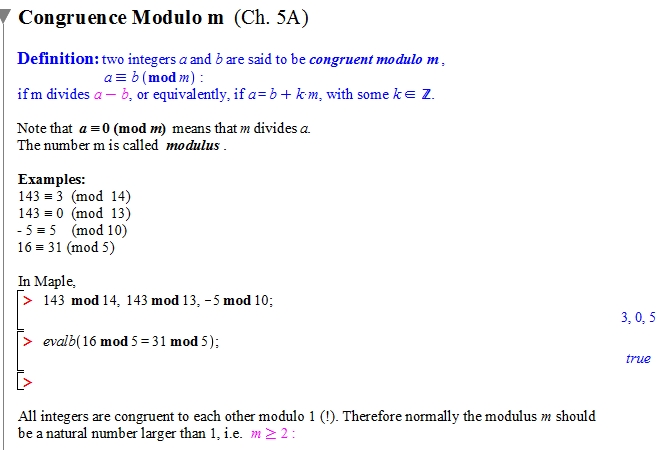COMP 367 notes
COMP 367: Techniques in Symbolic Computation
- Maple Software
- Maple commands
Lecture 1
Division Theorem:
- b = q*a + r, 0<=r<a, q>=0 and a, b>0
- a is
divisor, b isdivident, q isquotient, r isremainder a divides bis a|b , also calleda is a divisor of bora is a factor of b
GCD (greatest common divisor)
gcd(30,45)
common multiple
- 45 is a common multiple of 5 and 3.
- c = ab, (45 is c, 5,3=a,b)
prime: only two divisors: 1 and itself
ithprime(1003)seq(ithprime(i),i=1..10)
coprime: if (a,b) = 1- (lecture 2) ar + bs = 1
Euclid’s Algorithm:
- get quotient:
irem(365,121,'q')oriquo(365,121) - use list to calculate:( order is not important!!! )
EA := l::list->[l[2],l[1]-l[2]*iquo(l[1],l[2])];l1 := EA([aaa, bbb])l2 := EA(l1)
- use do-loop:
1
2
3
4
5l_n := EA([111,2222]);
do
l_n := EA(l_n)
until l_n[2] = 0:
l_n;
- get quotient:
need check with
gcd(a,b)
Lecture 2
Bezout’s Identity:
- if (a, b)=d then d = at + bs for some integers t and s

- if (a, b)=d then d = at + bs for some integers t and s
Extended Euclid’s Algorithm
- r = xa + yb
- find
row1androw2row1 := [y, 0, 1];row2 := [x, 1, 0];
- find 3rd and etc.
row3 := row1 - iquo(row1[1],row2[1])*row2- continue to other lines
- another function:
EEA := (l1,l2)->l1-l2*iquo(l1[1],l2[2]);- can use do-loop:
1
2
3
4
5
6
7
8k := 0:
m := 2:
do
k:=k+1:
m:=m+1:
row||m := EEA(row||k, row||(k+1));
print(row||m)
until row||m[1]=0:
- can use do-loop:
EEA := Matrix(4,3,[row1,row2,row3...])until the remainder of row is 0.- Corollary 8: if a divides bc and (a,b)=1, then a divides c
Diophantine Equations:
a*x + b*y = cis a linear Diophantine Equation- question is find a solution of the equation
- use
EEAfunction and steps above - For
General solution- when row is like
[0, z, w], then x0=zk, y0=wk where k is any integer. z need positive(+), if z is negative(-), exchange z and wsuch as [0, -9, 2]-> z=9, w=-21 = 2x+ yto find = 22, need to multiple 22, then22 = (2*22)x + (22)y- the general solution is
x=(2*22) + z,y = 22 + w
- when row is like
Factorization:
- Induction Theorem: Let P(n) be a statement that is defined for any integer n>= n0;
- (1) P(n0) is true
- (2) if P(n) is true for some n>=n0, then P(n+1) is also true.
ifactor(45);such as (3)^2(5)
- Induction Theorem: Let P(n) be a statement that is defined for any integer n>= n0;
Least Common Multiple (LCM):
- Proposition:
[a,b]=(a*b)/(a,b) lcm(210,126);result is 630.
- Proposition:
Lecture 3
Congruences
- Congruence Modulo m

143 mod 14, -5 mod 10evalb(16 mod 5 = 31 mod 5)is true
- properties:

- Proposition:

- ex:

- ex:
Linear Congruencies and Bezout’s Identity

- ex2:

- ex3:

- Proposition 19:

- ex:

- ex:
- Systems of Congruences:

Basic properties of congruences:
- properties:

- ex:

- ex:
- Proposition:

- Application of the exponentiation:
COMP 367 notes






